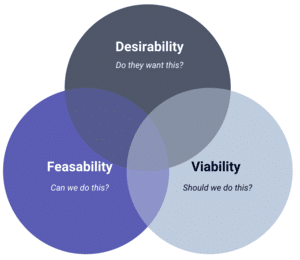No Concept? No Problem
Why You Shouldn’t Wait on Viability
We’ve all been there. You come up with a great idea for a new innovation – one that is really going to change the game and disrupt the industry. You work with your team to sketch up a concept. You might even develop a prototype. Then you get to the business case and realize that you’re stuck … you don’t know how you’re going to make money.

It is well-known in human-centered design that the innovation sweet spot is found at the intersection of desirability, feasibility, and viability. These three elements contribute to one another with desirability – what the consumer needs – usually as the starting point, and with feasibility – can we make this – and viability – where growth will come from and how will we make money – to follow once the concept is somewhat defined.
In our experience, however, conducting viability assessments earlier in the development process can help you clarify business objectives, inform data needs, and design simulations for chosen concepts. Put simply, conducting viability at the outset of the process can actually help develop a concept.
We recently worked with a client who didn’t have a clearly defined concept yet – neither the design, functionality, nor price point was finalized – but they needed a business case for investing. Sounds familiar?
Getting Viability Off the Ground Early:
We developed a flexible business case that helped inform concept design by focusing on the two pieces of viability – (1) identifying where growth will come from, and (2) understanding how to make money. The kicker is that we did this all before our client knew what the concept was going to be.
(1) Identify Sources of Growth
As most innovative design processes go, we started off by identifying and assessing multiple concept directions. This divergent activity is critical to innovation. The key difference when starting viability early, however, is that you let the growth levers lead the way, not the other way around.

Start by hypothesizing your growth levers. Do you have a retention problem (or objective)? Think about how you might lock consumers into your products (e.g., a subscription or closed system). Are your customers supplementing your products with purchases from a different brand? Perhaps there’s a product system that might make sense within your current capabilities (e.g., accessories or services). Maybe it’s not a “you problem,” but customers are on the fence about your product category entirely. Make it so easy that people can’t help but enter the category (e.g., try before you buy, satisfaction guarantees, etc.).
At the end of the divergence phase, our client landed on a product system as the go-forward approach.
(2) Assess Your Ability to Make Money (and use it to your advantage)
We built our viability assessment around critical assumptions that could be toggled so our client could visualize how strategic decisions affected potential revenue and margin.
If we created a closed system – how much would we realize in revenue from existing customers? What about new customers? Would that generate more revenue and margin than a subscription? What if we created an innovative product system that pulled new customers into the category? How much would we have to charge and at what margins?
Comparing the return of these options against potential concept designs helped our clients make important decisions about which design made the most sense for them to execute.
The bottom line: there is something to say about starting viability early. Identifying growth levers at the outset ensures you’re pointing the ship in the right direction and building the business case early keeps you from going down a rabbit hole on concept designs that offer no return. Include viability in your decision-making and use it to your advantage – you’ll find the innovative process much more efficient.



